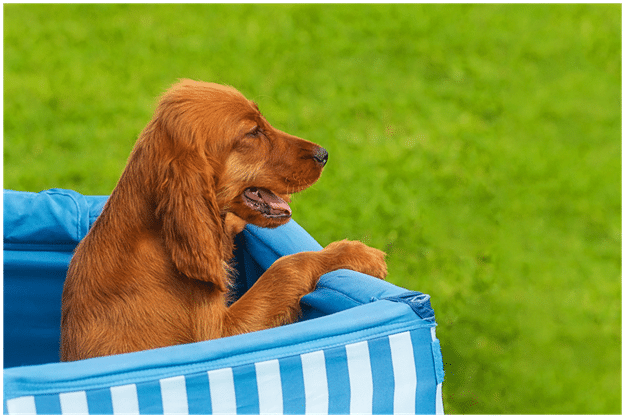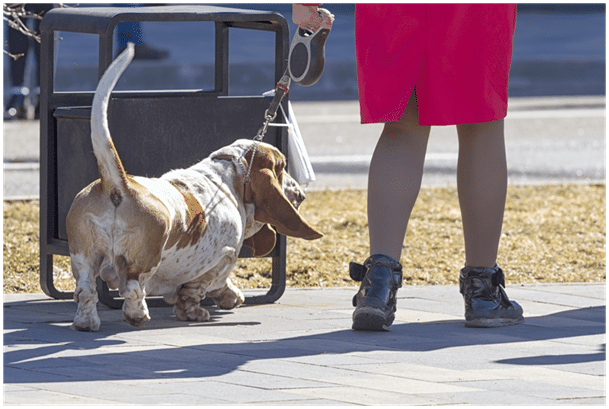Are you the proud new owner of a bloodhound puppy? If so, congratulations! This droopy-eared, gentle hound is a loving family pet and hunting dog. As with any new puppy, training your bloodhound is key to ensuring that he grows up to be a well-behaved and obedient dog.
So how to train my bloodhound puppy?
Bloodhound puppies should be trained from an early age, starting with crate training and housebreaking. This should be followed by obedience training and leash training. Consistency, patience, positive reinforcement, and lots of praise are critical when training your Bloodhound puppy.
Are Bloodhounds Easy to Train?
Many people believe that Bloodhounds are very easy to train, and this is generally true. As a popular scent hound, they are naturally well known for having a strong sense of smell.
They are also highly obedient family dogs and will quickly learn basic commands such as sit, stay, come, and down.
However, it is important to commence obedience training as early as possible so that the puppy can get into good habits from an early age.
Are Bloodhounds Obedient?
Bloodhounds are one of the most obedient dog breeds. They are quick to learn commands and will usually respond immediately to their owners’ requests. This makes them ideal for training as puppies, and also for obedience competitions.
It is not uncommon for Bloodhounds to win first prize in competitions involving obedience training.
How Hard is it to Train a Bloodhound?
Training a Bloodhound is not particularly difficult. However, it is important to be consistent with your methods and use the correct training techniques. It is also important to be patient.
These dogs are reasonably adaptable nd will quickly learn what is required of them, but they can also be quite stubborn at times. It is important to make sure that they receive plenty of exercise and playtime in order to keep them happy and healthy.
A good way to achieve this is to start crate training and housebreaking training from a young age. This will help keep your Bloodhound safe and healthy, as well as well-behaved.
Other than crate training, obedience training should start at an early age. Typically a Bloodhound can learn basic commands such as sit, stay, come, and down within a few weeks.
When Should I Start Training my Bloodhound Puppy?

Ideally, you should start training your Bloodhound puppy as soon as he or she comes home. This includes crate training, housebreaking, and obedience training.
It is important to be patient and consistent with your methods, including rewarding good behavior with food rewards, treats, and praise.
Bloodhounds need plenty of exercise and playtime, so make sure you allocate enough time for this each day. Leash training is also important, as Bloodhounds can be quite strong-willed.
How do you Train a Bloodhound Puppy?
There are a few key things to remember when training a Bloodhound puppy. Firstly, start crate training and housebreaking from an early age. This will help keep your puppy safe and healthy, as well as well-behaved.
Secondly, commence obedience training as soon as possible. Teach your puppy the basic commands such as sit, stay, come, and down.
Thirdly, make sure your puppy receives plenty of exercise and playtime. A good way to achieve this is to start leash training. This will help your puppy become a good-tempered, healthy family companion.
Start with Crate Training and Housebreaking
When you first bring your Bloodhound puppy home, it is important to start crate training and housebreaking. This will help keep your puppy safe and healthy, as well as well-behaved.
Make sure that you provide your puppy with plenty of water and food, and take him or her outside to relieve themselves frequently.
The easiest way to crate train your dog is to start when they are young. Puppies typically do not have any problems with using a crate as long as it is introduced to them correctly.
Start by putting your puppy in the crate for short periods of time, and gradually increase the amount of time they spend inside. Do not use the crate as a punishment, and always provide your dog with plenty of water and food.
Commence Obedience Training Early
Once your puppy has gotten used to his or her new home, it is important to commence obedience training. Teach your puppy the basic commands such as sit, stay, come and down.
Bloodhounds are highly intelligent and will quickly learn what is required of them. However, they can also be quite stubborn at times, so it is important to be patient and consistent with your methods.
Teach them basic commands such as sit, stay, come, and down
One of the best ways to train a scent hound is to teach them basic commands such as sit, stay, come, and down. Start this by getting your puppy’s attention and then giving the desired command.
Always use positive reinforcement such as treats or plenty of praise when your puppy follows your command. Be patient, as it may take a few weeks for them to fully understand what is required of them.
Teach your Puppy not to Jump on People or Bark Excessively
As a popular energy hound, Bloodhounds are known to become quite excitable around new people. You, therefore, need to teach your puppy not to jump on others or bark excessively.
This can be done by using a combination of positive reinforcement and discipline.
“When your puppy exhibits good behavior, reward them with treats and plenty of praise.“
However, if they start to behave inappropriately, reprimand them firmly and put them in time-out. Be consistent with your methods, and your puppy will soon learn what is expected of them.
Undertake Leash Training

Leash training is an important part of owning a Bloodhound puppy. These dogs can be quite strong-willed and may try to pull you around while on a walk.
Start leash training by putting your puppy on a leash and walking him or her around the house.
Once they are used to this, take them outside for a walk. Be patient, as it may take a while for your puppy to get used to walking on a leash.
Reward Good Behavior with Treats and Plenty of Praise
When it comes to rewarding a Bloodhound, tone of voice and positive reinforcement is key. This should be coupled with praise and yummy dog treats to ensure good behavior is rewarded.
This can be done by giving them treats, food rewards, or plenty of praise. This can include rewarding them for following basic commands, as well as behaving appropriately in public.
There are different types of treats that you can use to train your Bloodhound puppy. Some of the best options include small pieces of meat, cheese, or biscuits. Make sure that you always have a few treats on hand, as you will likely need them during the course of training.
Ensure Plenty of Exercise and Playtime
In addition to training, it is also important to make sure that your puppy has adequate exercise and playtime. Bloodhounds are high-energy dogs and need plenty of exercise to stay healthy and happy.
This can include playing fetch in the backyard, going on walks, or taking them to a park where they can run around. Make sure that you set aside enough time for your puppy to get the exercise they need each day.
“This also includes an adequate amount of mental stimulation, to ensure your Bloodhound doesn’t get bored.”
Always ensure your puppy has an adequate drink of water after exercising or playtime.
If you find that you have limited time to take your Bloodhound on walks, consider investing in a dog walker. This will ensure that your puppy gets the daily exercise they need each day. Alternatively, try to find a friend or family member who can help out with this.
Be Consistent with your Training Methods
One of the most important things when training a Bloodhound puppy is to be consistent with your methods.
This means using the same commands, rewards, and discipline techniques each time. If prospective owners are inconsistent, their puppies may become confused and not understand what is expected of them.
Show patience
It is also important to be patient when training a Bloodhound puppy. These dogs can be quite stubborn at times, so it may take a while for them to fully understand what is required of them.
However, with patience and consistency, you will be able to train your Bloodhound puppy to become a perfect addition to the family home.
Use Positive Reinforcement Whenever Possible
One of the best ways to train a Bloodhound puppy is to use positive reinforcement. This means rewarding them with treats or plenty of praise whenever they obey a command or behave appropriately.
This will help your puppy to associate good behavior with positive outcomes, which will make them more likely to obey commands in the future.
This is also likely to result in your puppy developing a docile temperament, which can help them become a trusted and loyal family dog.
On the contrary, negative reinforcement should be avoided when training a Bloodhound puppy. This involves punishing your puppy for bad behavior, which can often lead to them becoming fearful or anxious. As a result, this may make it more difficult to train them in the future.
Importance of Socialization
It is also critical to socialize your Bloodhound puppy from a young age. If you have other household pets, this should happen immediately. This also means exposing them to a variety of people, animals, and environments.
This will help them to become comfortable with new situations and surroundings, which can be important later in life.
If you are able to, try to take your puppy to different places on a regular basis. This could include going to the park, visiting friends or family, or taking them to a pet store. It is also important to introduce your puppy to new people and animals on a frequent basis.
This will help them to become comfortable with new faces and will teach them how to interact appropriately with other beings.
Final thoughts
Training a Bloodhound puppy can be a challenging but rewarding experience. By using positive reinforcement, providing plenty of exercise, and socializing your puppy from an early age, you can help them to become a well-behaved member of the family.


